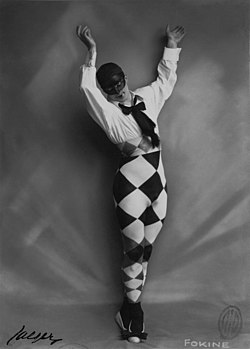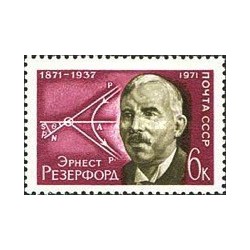- جدید
- ناموجود



توجه : درج کد پستی و شماره تلفن همراه و ثابت جهت ارسال مرسوله الزامیست .
توجه:حداقل ارزش بسته سفارش شده بدون هزینه پستی می بایست 100000 ریال باشد .
توجه : جهت برخورداری از مزایای در نظر گرفته شده برای مشتریان لطفا ثبت نام نمائید.
| Michael Fokine | |
|---|---|
 Michel Fokine in Arlequin, 1914
|
|
| Native name | Михаи́л Миха́йлович Фо́кин |
| Born | Mikhaíl Mikháylovich Fokín (1880-04-23)23 April 1880 Saint Petersburg, Russian Empire |
| Died | 22 August 1942(1942-08-22) (aged 62) New York City, U.S |
| Nationality | Russian, naturalized U.S. |
| Occupation | Ballet dancer, choreographer |
| Spouse(s) | Vera Fokina |

Michael Fokine (a French transliteration Michel Fokine; English transliteration Mikhail Fokin; Russian: Михаи́л Миха́йлович Фо́кин, Mikhaíl Mikháylovich Fokín) (23 April [O.S. 11 April] 1880 – 22 August 1942) was a groundbreaking Russian choreographer and dancer.
Fokine was born in Saint Petersburg, as son of a prosperous, middle-class merchant and at the age of 9, he was accepted into the Saint Petersburg Imperial Ballet School (Vaganova Ballet Academy). In 1898, on his 18th birthday, he debuted on the stage of the Imperial Mariinsky Theatre in Paquita, with the Imperial Russian Ballet (now the Mariinsky Ballet). In 1902, he became a teacher of the ballet school. Among his students were Desha Delteil and Bronislava Nijinska.
Fokine aspired to move beyond stereotypical ballet traditions. Virtuoso ballet techniques to him were not an end in themselves, but a means of expression. He also believed that many of the ballets of his time used costuming and mime that did not reflect the themes conveyed in the ballets. Therefore, Fokine sought to strip ballets of their artificial miming and outdated costumes. Fokine studied Greek and Egyptian art, including vase-painting and sculpture, which aided the development of his themes.
In addition, as a choreographer, he initiated a reform that took ballerinas out of their pointe shoes and also experimented with a freer use of the arms and torso. He presented his reformist ideas to the management of the Imperial theatre, but did not win their support. One such request was to have his dancers perform barefoot in his 1907 ballet Eunice. Since his request was denied, Fokine had toes painted on the dancers' tights so they would appear to be barefoot.
Some of his early works include the ballet Acis and Galatea (1905) and The Dying Swan (1907), which was a solo dance for Anna Pavlova, choreographed to the music of Le Cygne. Acis and Galetea included an acrobatic dance with young boys playing fauns; one of those boys was Vaslav Nijinsky. Fokine later featured Nijinsky in a number of ballets, including Chopiniana (1907), ultimately renamed Les Sylphides in 1909.
In 1909, Sergei Diaghilev invited Fokine to become the resident choreographer of his Ballets Russes in Paris. Fokine's years with Ballets Russes were successful, collaborating with other artists to create a ballet of Nikolai Rimsky-Korsakov's Scheherazade which premiered in 1910. This ballet was inspired by symphonic poems composed by Rimsky-Korsakov and ancient tales of 1001 nights also known as the Arabian nights. The spectacular sets designed by Léon Bakst matched the sexually charged choreography. Despite his lack of historic accuracy, the ballet was widely successful due to its brilliant colors, exoticism and sexual overtones. [1] (1910, featuring Vaslav Nijinsky in the role of the Golden Slave); The Firebird (1910) was also created by a "committee," a system inspired by the Wagnerian notion of Gesamtkunstwerk, which translates as the synthesis of theatrical elements like; music, drama, spectacle and dance, giving birth to a more cohesive art work. Petrushka (1911), with music composed by Igor Stravinsky and sets designs by Alexandre Benois Petrouchka was inspired by the Russian puppet which traditionally appeared at the Butter Week Fairs. In this ballet Fokine included, street dancers, peddlers, nursemaids a performing bear and a large ensemble of characters that complemented the plot. The story was centered on the sinister Magician (Enricco Ceccetti) and his three puppets; Petrouchka (Nijinsky) the Ballerina (Karsavina) and the savage Moor (Alexander Orlov) and Daphnis et Chloé (1912). Fokine's ballet Le Spectre de la Rose (1911) showcased Nijinsky as the spirit of the rose given to a young girl. His exit featured a grand jeté out of the young girl's bedroom window, timed so the audience would last see him suspended in mid-air.
Fokine left Ballets Russes in 1912, however, jealous that Diaghilev had asked Nijinsky to choreograph the avant-garde L'après-midi d'un faune.[citation needed] A year later (after Nijinsky was fired), Diaghilev was obliged to re-hire Fokine,who made it a condition of his re-employment that none of Nijinsky's choreography would be performed.[2] The Paris premiere of The Golden Cockerel by Ballets Russes in 1914 was an opera-ballet, guided by Fokine with set designs by Natalia Goncharova.
The outbreak of the First World War in August 1914 disrupted the established touring circuit, which included countries now on opposing sides, and caused a number of dancers, including Fokine, to return to their own countries. He moved to Sweden with his family in 1918 and later established his home in New York City, where he founded a ballet school and continued to appear with his wife, Vera Fokina. He became a United States citizen in 1932.
In 1937, Fokine joined Col. Wassily de Basil's Ballets Russes offshoot, eventually named the Original Ballet Russe. Among the new works he created during this period were Cendrillon (1938) and Paganini (1939). Fokine's choreography was featured with the company through 1941.
Fokine staged more than 70 ballets in Europe and the United States. His best-known works were Chopiniana, (later revised as Les Sylphides), Le Carnaval (1910), and Le Pavillon d'Armide (1907). His pieces are still performed by the leading ballet troupes of the world, the Mariinsky Ballet having performed a retrospective of his works at London's Covent Garden in late July 2011.
Fokine died in New York on 22 August 1942.
تشکر نظر شما نمی تواند ارسال شود
گزارش کردن نظر
گزارش ارسال شد
گزارش شما نمی تواند ارسال شود
بررسی خود را بنویسید
نظر ارسال شد
نظر شما نمی تواند ارسال شود

check_circle
check_circle
















